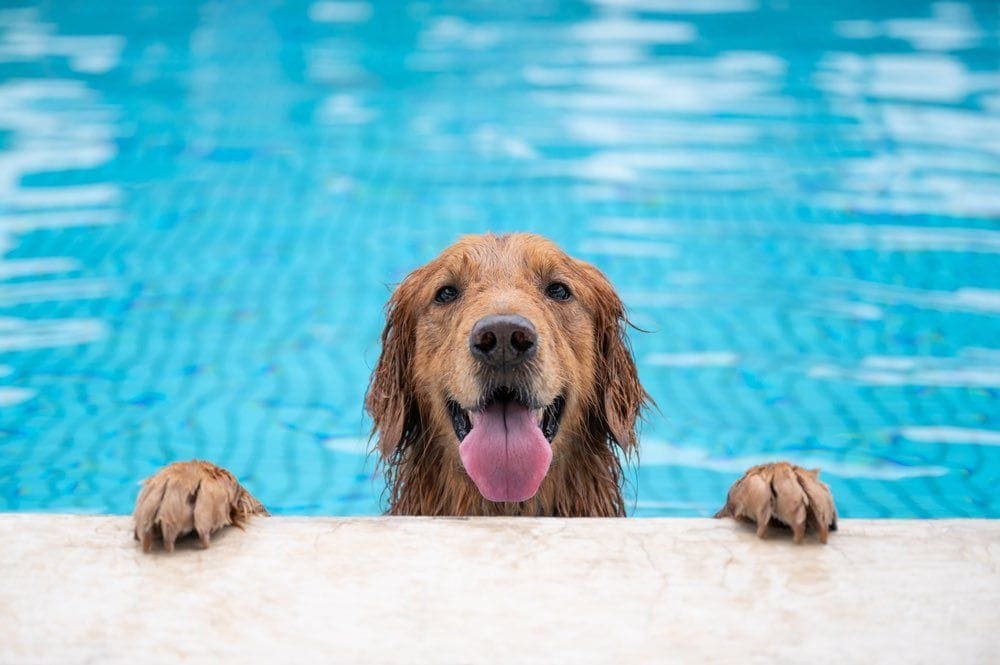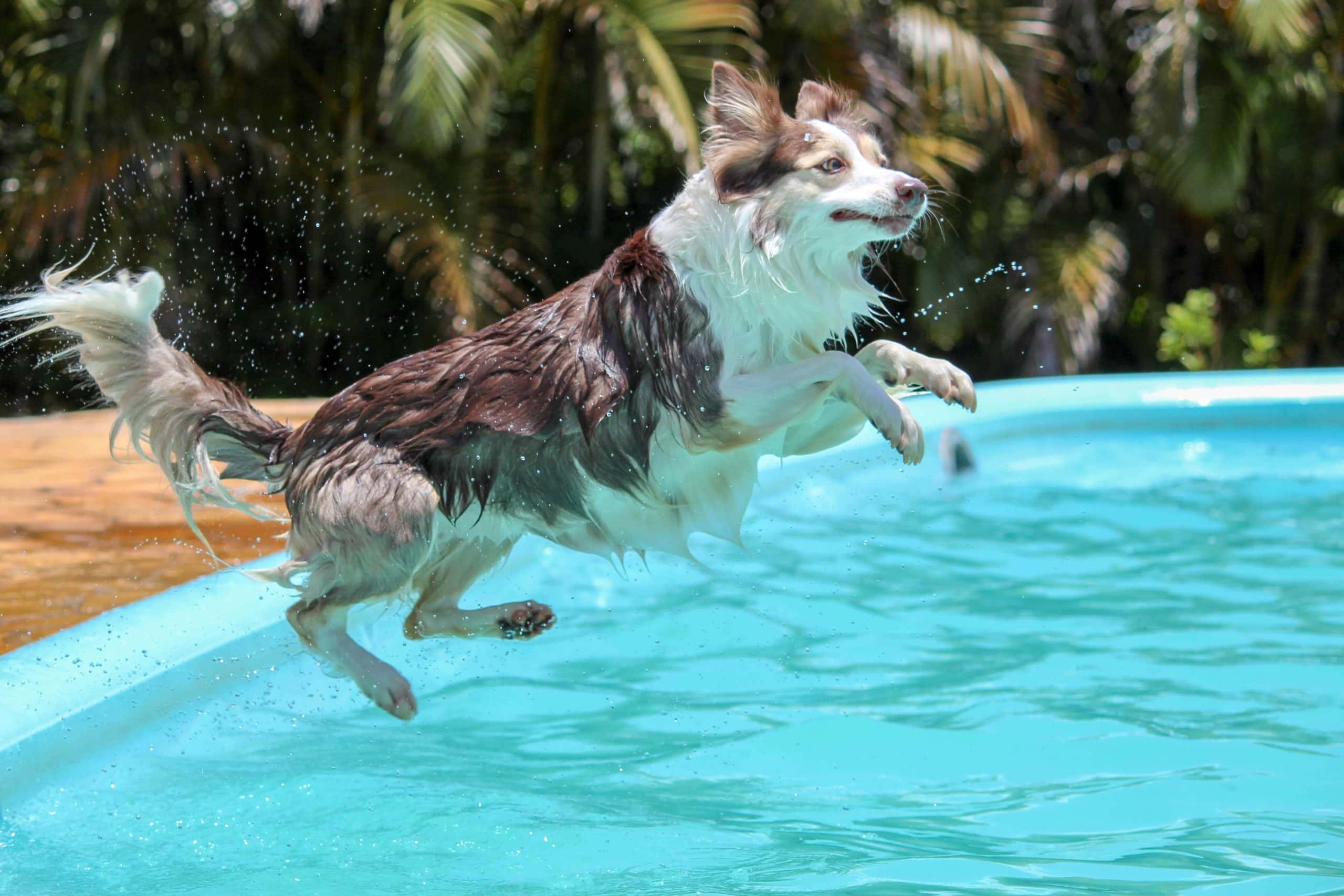Is It Safe for My Dog to Swim in the Pool? What You Need to Know!
-
Pete Ortiz
- Last updated:

Few things are sadder than listening to your best friend whimper because he or she wants to get into the pool with the rest of the family, but many dog owners may question whether or not allowing their pet in the pool is safe.
Besides chlorine, there may be other hazards as well, and there are several things to consider before giving the all-clear.
Let’s take an in-depth look at pool safety for dogs to see if it’s a good idea to swim with your pet. We’ll look at what precautions you might take to improve safety and ensure an excellent experience for everyone.
Benefits of Swimming
Besides feeling like a part of the family, your pet will benefit in several ways from going for a regular swim.
- It’s an excellent cardiovascular workout. One minute of swimming can equal several minutes of walking or even running.
- It’s easy on your pet’s joints. Swimming is one of the only ways to do zero-impact exercise, which creates no pounding on the bone, which could lead to damage down the road.
- Because it’s low impact and water supports the body, swimming can even be done by overweight dogs to help them with weight management.
- It will help cool your pet down on hot summer days. Some dogs have a difficult time staying cool in the summer and going for a quick swim can really help.

Will Chlorine Harm My Dog?
Chlorine’s effect on dogs is similar to its effect on humans. Chlorine can burn our eyes and our nose if the chemical balance has too much chlorine, or there’s too much-combined chlorine (also known as chloramines) in the water and it needs to be shocked. Chloramines are a byproduct of chlorine, and you can tell if there are too many because it will smell of chlorine—first, the smell, then the burning eyes, then the itchy skin.
Tip 1
- A properly maintained pool will have no odor
Your dog will suffer from the same effects from too much chlorine. However, your dog’s ears are very thin and more sensitive to high chlorine levels. Dogs also tend to ingest more water than humans will. Drinking too much chlorinated water could lead to stomach cramps or diarrhea. Too much chlorine on the ears could cause some itching and dryness.
If you want to take your pet into the pool, you’ll need to keep the chloramines low and the chlorine level low as well.
Other Dog Dangers
As we mentioned earlier, chlorine isn’t the only danger your dog faces in the pool. The biggest danger for your dog in the swimming pool is the floating chlorine tablets. While the small amount of chlorine in the water won’t hurt your dog, chewing on a chlorine tablet will. You’ll need to remove any chlorine floaters, and if you use granulated chlorine, you’ll need to check the surface of your pool because granulated chlorine floats for quite a while.
While it is quite rare, some dogs get their paw stuck in the skimmer. If this happens, it can scare the dog, and some dogs also have a hard time with the walls of above-ground swimming pools. If your pet is unsure of the water, let them take some time to get used to it before playing any games.

Tip 2
- Shut the pool pump and filter off and use the winter skimmer cover while your pet is in the pool
Also, make sure your pet knows how to get out of the pool, and has tried it a few times before you do any rough play in the water. Dogs often find it hard to use the ladder the first few times, and it’s one of the biggest causes for them getting scared.
Tip 3
- Use a dog ramp to help your pet out of the pool
Dangers for the Owner
With your pet’s safety taken care of, there are still a few things to consider before allowing your pet into the pool. The main thing to worry about here is their sharp nails, and a larger dog may be able to puncture the liner. Dogs can also puncture your floats and rafts as they swim around the pool, and they may even accidentally scratch someone.
These problems are rare, though, and you only need to be concerned if your pet looks scared or hesitant to get into the water. Most dogs enjoy swimming and will be right at home in the water.
Tip 4
- Fence in your pool and only allow your pet in the pool while you are supervising
Dog Mess
Like it or not, your dog sheds a lot of hair and will do so in your pool. The longer your dog stays in the water, the more hair they will leave behind. You will need to do some extra hand skimming, and you’ll also have to check the skimmer basket regularly to keep it from being blocked with hair. You should not notice any increased pump pressure, though, or anything like that. Dog hair will not clog your filter.
Tip 5
- Hose your pet off before they get into the pool to get some of the loose hair off
 Conclusion
Conclusion
There’s absolutely nothing wrong with taking your pet into the pool with you, and as long as you keep the chemicals well balanced, there’s no danger to your dog’s health from the chlorine. We recommend hosing your dog off once they have gotten out of the pool to get any excess chlorine or other chemicals off their fur. Always take special care to get the ears dry immediately and watch for any signs that your dog’s ears can be suffering from the effects of chlorine. An itchy ear is a dead giveaway.
Use treats and other training methods to show them how to get out of the pool before anything else. The most significant danger will come from your pet getting scared by a passing truck or something like that, and not being able to get out of the pool fast enough. Proper training can prevent that.
Keep the pool fenced-in and never allow your pet to swim unsupervised. Watch for signs that your pet may be getting tired while swimming. Don’t let them swim too longer than 30 minutes at a time and keep plenty of fresh water nearby, so they don’t drink the pool water.
If reading this has helped your pet get in the pool with the family, please share this short guide to dog swimming safety on Facebook and Twitter.
Check out some of our top trending posts:
- 7 Best Pool Slides: Reviews & Top Picks
- 5 Best Pool Booster Pumps of the Year
- 10 Common Swimming Pool Myths: Busted!
Featured image credit: Chendongshan, Shutterstock
Contents


